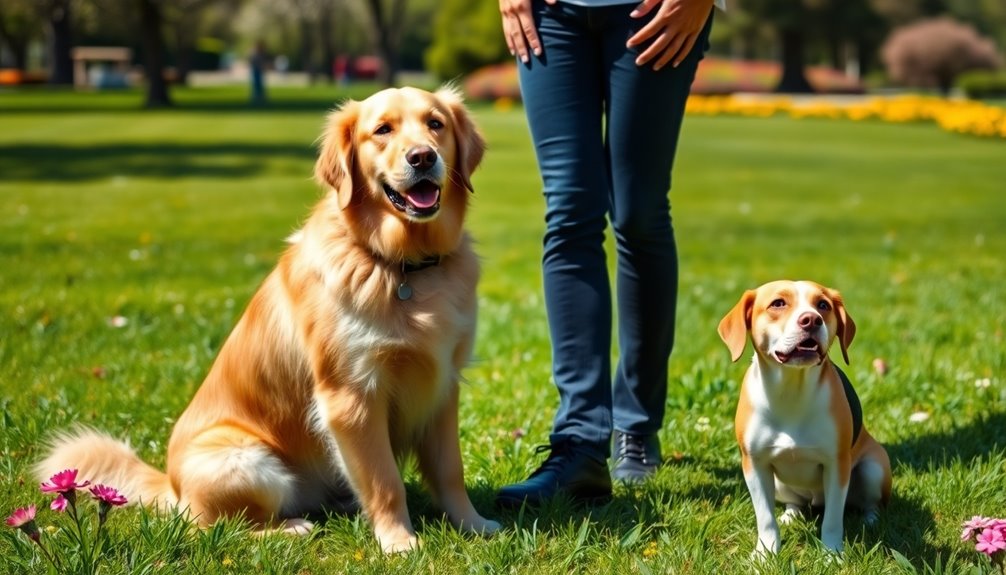Your dog won't listen due to confusion, fear, or inconsistent training. If family members use different commands or your dog feels anxious, it's harder for them to respond correctly. You can change this by establishing clear communication with consistent commands and positive reinforcement. Start training in a calm, distraction-free environment, gradually introducing challenges as your dog becomes more comfortable. Always reward good behavior immediately to strengthen their understanding. Also, make sure to manage your dog's energy levels for better focus. Discover more strategies to enhance training and transform your dog's behavior beautifully.
Key Takeaways
- Dogs may not listen due to fear or anxiety from past experiences, requiring gradual desensitization and positive reinforcement to build confidence.
- Inconsistent commands from family members create confusion; ensure everyone uses the same verbal and visual cues for clarity.
- Excessive distractions can hinder obedience; start training in low-distraction environments and gradually introduce more challenges as your dog improves.
- Engaging in fun exercises and providing immediate rewards during training sessions can enhance motivation and strengthen the bond between you and your dog.
- Tailor training sessions based on your dog's energy levels; tiring them out beforehand can lead to better focus and responsiveness during training.
Common Reasons for Disobedience

Understanding why your dog won't listen is essential to improving their behavior. One common reason for disobedience is fear of stimuli. Loud noises or unfamiliar objects can cause your dog to shut down, making them less likely to respond to commands.
Additionally, confusion from inconsistent commands given by different family members can hinder your dog's understanding. Dogs thrive on clear and consistent communication, so it's critical to guarantee everyone's on the same page during dog training.
Distractions are another significant factor. External influences, like other animals or loud noises, can easily divert your dog's attention during training sessions. When the environment is overly stimulating, your dog may choose to ignore commands simply because they're more interested in their surroundings.
Moreover, if your dog is given too much freedom, they might practice selective listening, prioritizing their own interests over your commands.
Recognizing these reasons your dog mightn't listen is essential. By understanding these factors, you can tailor your dog training strategies to address their specific needs and behaviors effectively, leading to better communication and obedience.
Importance of Consistent Training
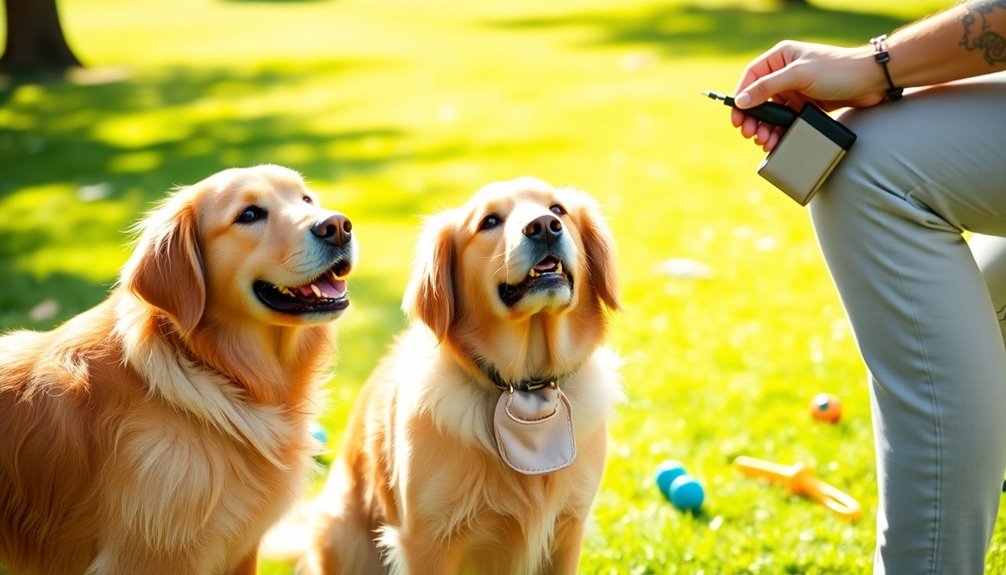
Consistency is key when it comes to training your dog effectively. If you and your family aren't on the same page, your dog will get mixed signals, making it tough for them to learn. Using the same clear commands is crucial; for example, stick to "SIT" instead of variations like "SIT DOWN." Consistent training helps prevent confusion.
Additionally, your tone of voice and body language should remain uniform. Dogs respond better to consistent cues, so if you or another family member change how you communicate commands, it can throw your dog off.
Here's a simple way to guarantee everyone's on board:
| Command | Family Member A | Family Member B |
|---|---|---|
| Sit | SIT | SIT |
| Stay | STAY | STAY |
| Come | COME | COME |
| Down | DOWN | DOWN |
| Leave It | LEAVE IT | LEAVE IT |
Regular practice and positive reinforcement are essential. By maintaining a unified approach and reinforcing learned behaviors, you'll help your dog retain skills over time, leading to a more obedient companion.
Effective Communication Techniques
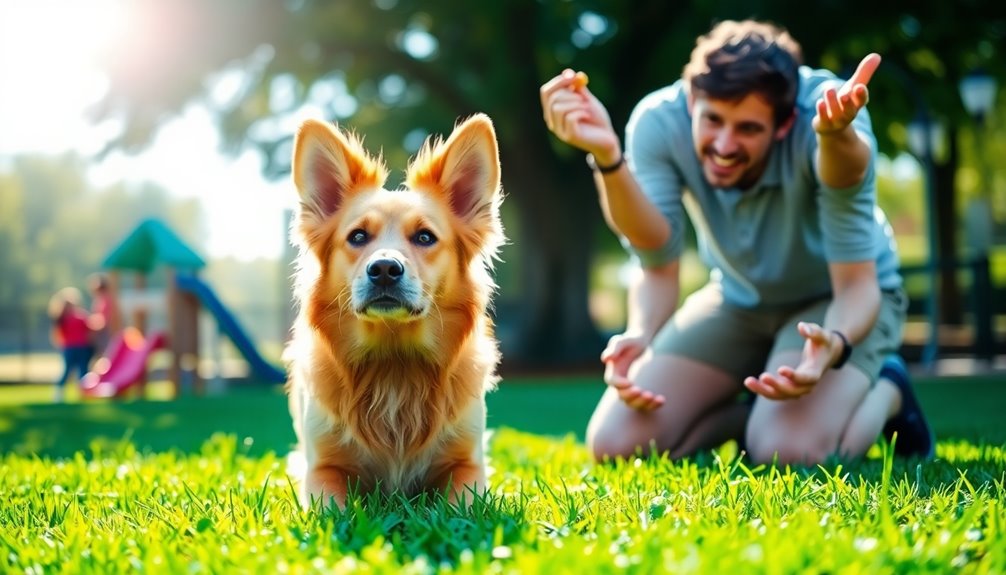
To get your dog to listen, effective communication is key.
Use consistent commands and a clear tone to help your pup understand what you expect.
Consistent Command Usage
Effective communication with your dog hinges on consistent command usage. Dogs thrive on clarity and repetition, so using the same commands every time helps your dog understand what you expect. Stick to one-word commands like "SIT" instead of phrases like "SIT DOWN." This minimizes confusion and strengthens your dog's association with the desired behavior.
It's essential that everyone in your household uses the same commands. Mixed signals can confuse your dog, leading to frustration for both of you. Choose a set of commands and make sure that all family members are on board. This consistency reinforces learning and makes it easier for your dog to respond.
In addition to verbal commands, consider incorporating visual cues. Dogs are often more attuned to body language than spoken words alone, so pairing your commands with gestures can enhance understanding.
For example, use your hand to signal "SIT" while saying the command. This dual approach aids in reinforcing the message, making certain your dog understands.
Clear Tone Importance
Using a clear tone when communicating with your dog can greatly enhance their understanding and responsiveness. Dogs thrive on consistency, so maintaining a steady tone is vital. When you use a calm and positive tone, it reinforces good behavior. Conversely, harsh or inconsistent tones can confuse your dog, making them less likely to listen.
Here's a quick overview of effective tone usage:
| Tone Type | Purpose |
|---|---|
| Calm & Positive | Reinforces good behavior |
| Firm | Corrects unwanted behavior |
| High-Pitched Praise | Signals positive reinforcement |
| Low-Pitched Warning | Indicates a mistake |
Positive Reinforcement Strategies
Positive reinforcement is a powerful tool in dog training that helps you communicate desired behaviors clearly and effectively. By rewarding your dog immediately after they perform a desired action, you make it clear which behaviors are encouraged, enhancing their learning retention.
Using high-value treats during training sessions can considerably boost your dog's motivation, especially in distracting environments.
Consistency is key; always use the same verbal cues and maintain a similar tone of voice to reinforce understanding and adherence to commands. Incorporating both verbal and visual cues, such as hand signals, can further improve communication effectiveness.
Dogs often respond better to body language than spoken words alone, so pairing commands with gestures is beneficial.
Engaging in fun exercises that utilize positive reinforcement not only aids in training your dog but also strengthens the bond between you. This creates a more motivated and responsive environment for learning.
Managing Distractions During Training

When training your dog, start in low-distraction environments to help them focus on your commands.
As they get comfortable, gradually introduce distractions to build their resilience.
This approach not only reinforces their learning but also prepares them to respond well in various situations.
Low-Distraction Environments
To guarantee your dog learns effectively, start training in low-distraction environments. These settings help your dog focus and grasp commands better, laying a solid foundation for their learning journey.
When you reduce noise and eliminate the presence of other animals, you minimize potential interruptions, allowing for clearer communication. This way, your dog can concentrate fully on the task at hand.
Consistency is key; training in familiar locations reinforces learning. Dogs often perform better in environments they recognize, making it easier for them to absorb new commands.
Keep your training sessions short to maintain your dog's interest and attention. This approach leads to more effective outcomes as your dog remains engaged throughout the process.
Gradual Exposure Techniques
Gradual exposure techniques are essential for helping your dog learn to manage distractions effectively. Start your training sessions in low-distraction environments where your dog can focus without overwhelming stimuli. This foundation is vital before you gradually introduce new sounds, sights, or even other animals.
By incrementally increasing distractions, you allow your dog to adjust without feeling stressed. Consistency is key, so keep practicing in familiar settings to reinforce what your dog learns. As you progress, gradually expose your dog to new environments to enhance their adaptability and focus over time.
Remember, short, frequent training sessions are more effective than long ones. They help maintain your dog's attention and reduce anxiety when faced with distractions.
Always use positive reinforcement immediately after your dog successfully responds in the presence of distractions. This strengthens the link between compliance and rewards, making it more likely that your dog will listen in the future.
Incorporate these training tips into your sessions to effectively manage distractions and help your dog become a more attentive companion. With patience and persistence, you'll see significant improvements in your dog's listening skills.
Addressing Fear and Anxiety
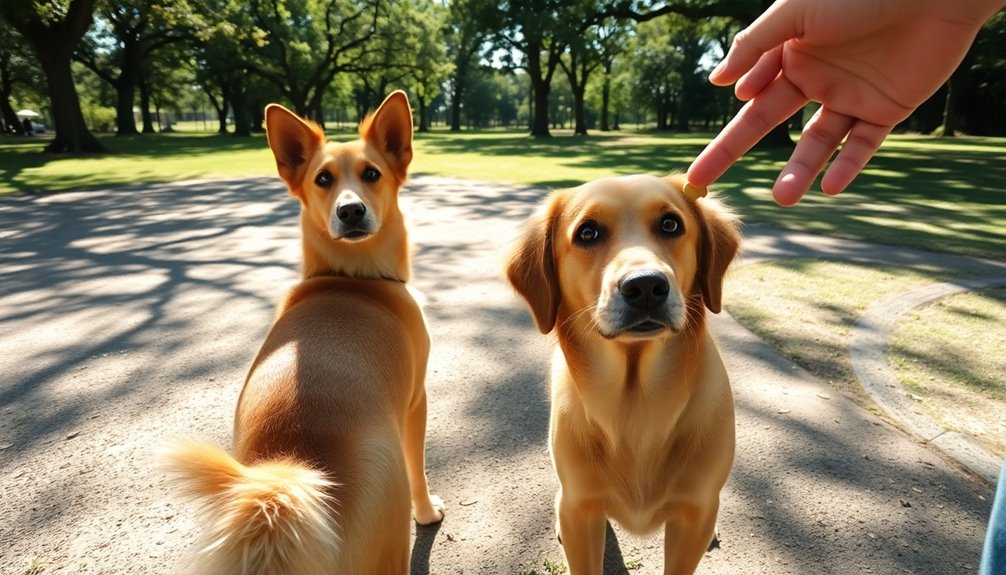
Many dog owners find that their pets won't listen during moments of fear and anxiety. This non-compliance often stems from heightened emotional states, making it essential to identify and address specific triggers. Start by observing what causes your dog's fear or anxiety. It could be loud noises, unfamiliar people, or certain environments.
Gradual desensitization to these stimuli, combined with positive reinforcement, can effectively help your dog build confidence over time. When training, focus on low-distraction environments to help your anxious dog concentrate better. High-stimulus settings can exacerbate their fear responses, making it harder for them to follow commands.
Additionally, understanding your dog's background and any past traumas will allow you to tailor your training approaches, prioritizing their emotional well-being. Incorporating regular calming techniques, like deep breathing exercises or creating a safe space, can greatly enhance your dog's ability to respond to commands despite their underlying anxiety.
Building a Strong Bond
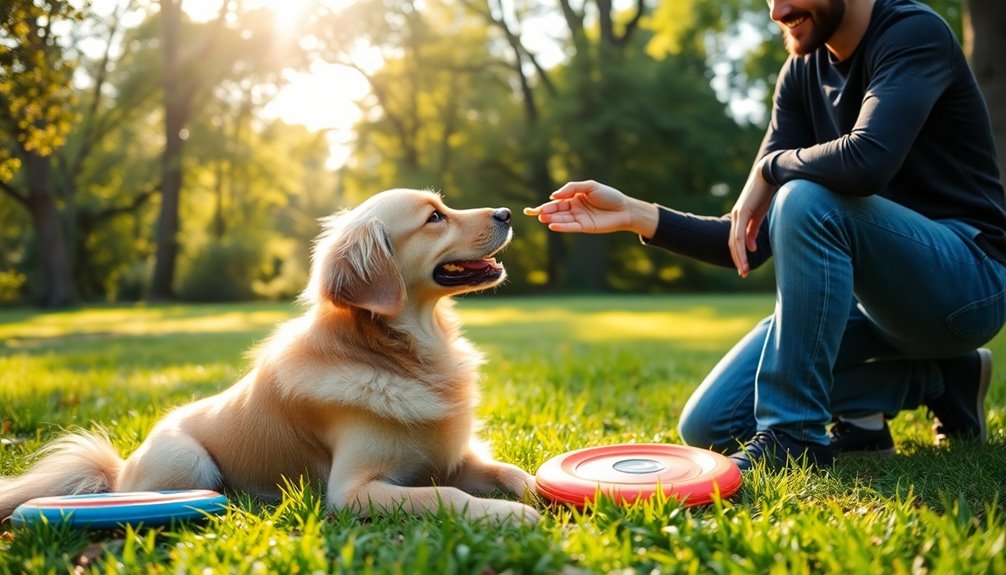
To get your dog to listen, you need to build a strong bond based on trust and respect.
Using consistent communication methods and positive reinforcement techniques makes a huge difference in how your dog responds to you.
When you establish this connection, you'll notice a significant improvement in their willingness to engage and obey.
Trust and Respect
Building trust and respect with your dog is essential for fostering a strong bond that encourages obedience. Dogs thrive in structured environments where they clearly understand their role and your leadership. To achieve this, you need to be consistent in your commands and behaviors. When all family members use the same cues, it prevents confusion and creates a stable atmosphere for your dog.
Using positive reinforcement is another vital element. By rewarding desired behaviors, you're not just encouraging them but also strengthening the trust between you and your dog. This makes your pet more likely to listen and respond to you.
Establishing yourself as a pack leader doesn't mean being dominant; instead, it involves providing guidance and control. This approach promotes a trusting relationship that enhances obedience.
Investing time in training while developing a strong emotional connection with your dog leads to lifelong loyalty. The more effort you put into building this trust and respect, the more responsive your dog will become.
Consistent Communication Methods
Consistent communication methods are key to strengthening the bond between you and your dog. Using the same verbal commands every time is essential; different phrases can confuse your dog and hinder their understanding. Stick to one clear word per command to establish clarity. This consistency helps your dog know exactly what you expect, reducing frustration for both of you.
Incorporating visual cues alongside verbal commands can enhance your communication. Dogs often respond better to body language than words alone, so using hand signals or gestures can reinforce your message. Regular training sessions will build your dog's skills and foster a stronger bond, encouraging them to exhibit desired behaviors.
Additionally, maintain a calm and positive demeanor during training. Dogs are sensitive to your emotional energy, and a relaxed atmosphere will greatly improve their responsiveness.
When you communicate clearly and consistently, your dog will feel more secure in understanding what you want, leading to better cooperation. Remember, a strong bond built on consistent communication will make your training efforts more effective and enjoyable for both of you.
Positive Reinforcement Techniques
Positive reinforcement techniques create a rewarding environment that fosters cooperation and trust between you and your dog. By rewarding desired behaviors immediately with treats, praise, or play, you enhance your dog's understanding and compliance with commands.
Consistency is key; using high-value treats during training sessions boosts motivation and helps your dog connect specific behaviors with positive outcomes. Engaging in fun exercises that incorporate positive reinforcement not only strengthens command recognition but also makes training enjoyable for both of you.
This approach builds a strong bond through positive interactions, encouraging your dog to listen more attentively. When you reward good behavior and spend quality time together, your dog learns to associate you with positive experiences, leading to improved responsiveness and obedience.
Regularly practicing these techniques creates a stable environment where your dog feels secure. A secure dog is much more willing to listen to you, making training sessions productive and effective.
Tailoring Training for Older Dogs
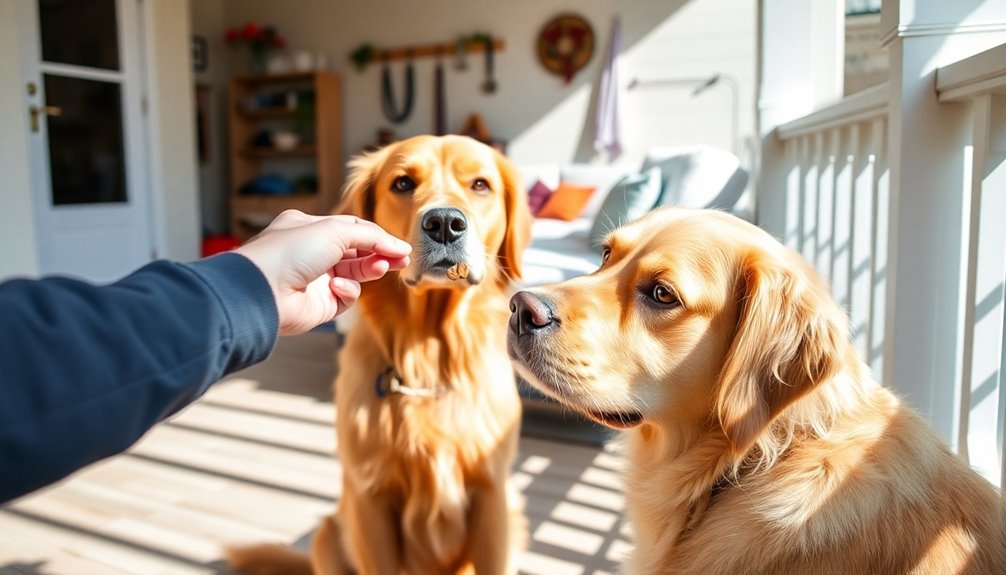
Many older dogs are more than capable of learning new commands and behaviors, but training them requires a different approach. Patience and consistency are vital, as improvements may take weeks based on your dog's history and behavior.
To effectively train your dog, make certain that all family members use the same commands and cues. Mixed signals can confuse your older dog, making it harder for them to respond.
Using positive reinforcement is essential. This method encourages desired behaviors while building trust, avoiding punitive measures that can harm your relationship.
Tailor training sessions to your dog's physical capabilities, incorporating shorter, engaging exercises to keep their interest and focus.
Establishing Leadership and Trust

How can you establish effective leadership and trust with your dog? Start by creating a structured environment where your dog knows its role in the household. This clarity fosters a sense of security and obedience.
Consistent and positive interactions are key; dogs thrive on predictability, so your behavior and commands should be clear and reliable.
Patience and persistence are vital for establishing leadership. Reinforce commands consistently to encourage the behaviors you want to see. Your dog is sensitive to your emotional energy, so maintaining a calm and confident demeanor will promote trust and enhance communication. This can greatly improve your dog's responsiveness to your commands.
It's also important to guarantee that everyone in your household is on the same page. Mixed signals or inconsistent commands can undermine your leadership, confusing your dog and making training more challenging.
A unified approach to training and communication will help solidify your role as a leader and build trust. By establishing leadership and trust, you'll set a solid foundation for a more responsive and obedient dog.
Utilizing Positive Reinforcement

There's no doubt that utilizing positive reinforcement can transform your dog's training experience. By rewarding your dog immediately after they perform a desired behavior, you greatly enhance their understanding and retention of basic commands.
Using high-value treats during training sessions can boost your dog's motivation, making them more likely to respond positively when they find the reward exciting.
Consistency is essential in your approach. Dogs learn better when they receive the same type of reinforcement for the same behavior every time, reinforcing the connection between the action and the reward.
Engaging in fun exercises that involve positive reinforcement not only strengthens command recognition but also builds a deeper bond between you and your dog.
It's important to avoid using bribes; instead, focus on genuine positive reinforcement. This fosters a motivated and engaged dog, leading to more effective training outcomes.
By incorporating these strategies, you'll notice a marked improvement in your dog's responsiveness, making training sessions more enjoyable for both of you.
Overcoming Behavioral Challenges

When facing behavioral challenges, it's important to identify the root causes that may be preventing your dog from listening. Often, distractions like other animals or loud noises can make it hard for your dog to focus.
Start training in low-distraction areas to help your dog learn without interruptions. If your dog isn't listening due to fear or anxiety from past traumas, consider gradual desensitization paired with positive reinforcement to build their confidence.
Consistency among all family members is essential. Mixed signals can confuse your dog, leading to disobedience. Make sure everyone uses the same commands and signals, both verbal and visual, to establish clear communication.
Excess energy can also hinder your dog's ability to engage during training. Prioritize physical activities before your sessions to help tire them out.
A tired dog will be more focused and responsive to your commands.
Frequently Asked Questions
How Do You Discipline a Dog That Doesn't Listen?
Disciplining a dog that doesn't listen can be challenging, but it doesn't have to involve punishment. Instead, focus on using positive reinforcement techniques. Reward your dog with treats and praise when they follow commands.
Keep your commands clear and consistent, using one word per command to avoid confusion. Stay calm and patient during training sessions, and gradually expose your dog to different environments.
If issues persist, consider seeking professional help for tailored strategies.
How Do You Fix a Disobedient Dog?
Fixing a disobedient dog isn't impossible, even if it feels overwhelming.
Start by establishing clear commands that everyone in your household uses consistently. Reward your dog immediately for good behavior to reinforce learning.
Keep training sessions short and fun to maintain focus, especially in distracting places. Gradually introduce new environments, and always check your dog's energy levels—an engaged, well-rested dog is more likely to respond positively to your commands.
How Do I Show My Dog I Am the Alpha?
To show your dog you're the alpha, establish clear leadership through consistent commands.
Make sure everyone in your household uses the same cues to avoid confusion.
Create a structured environment with set boundaries and routines, which reinforces your role.
Use positive reinforcement to reward good behavior, fostering trust and encouraging your dog to look to you for guidance.
What to Do if a Dog Isn't Listening to Commands?
If your dog isn't listening to commands, start by ensuring your cues are clear and consistent.
Use one specific word for each action to avoid confusion. Reinforce good behavior with immediate praise or treats when they do respond.
Train in a quiet, familiar space before gradually adding distractions. Pay attention to your dog's body language; anxiety can impact their ability to understand.
Regularly test their commands in different situations to strengthen their learning.
Conclusion
So, you see, transforming your dog from a rebellious rascal into a well-mannered companion isn't just a dream—it's absolutely possible! With a sprinkle of patience, a dash of consistency, and a whole lot of love, you'll turn every chaotic moment into a symphony of obedience. By embracing effective communication and positive reinforcement, you'll forge an unbreakable bond that'll make your dog listen like a pro. Get ready to release the best version of your furry friend!





